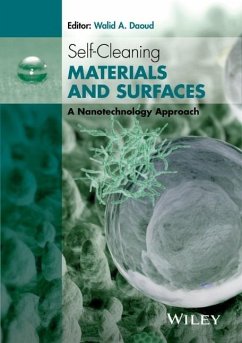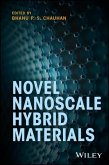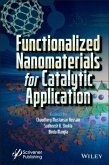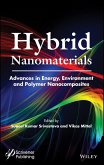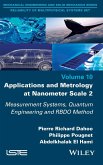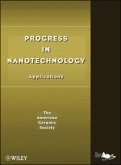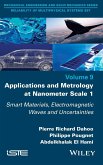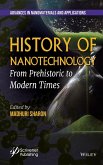Self-Cleaning Materials and Surfaces
A Nanotechnology Approach
Herausgeber: Daoud, Walid A
Schade – dieser Artikel ist leider ausverkauft. Sobald wir wissen, ob und wann der Artikel wieder verfügbar ist, informieren wir Sie an dieser Stelle.
Self-Cleaning Materials and Surfaces
A Nanotechnology Approach
Herausgeber: Daoud, Walid A
- Gebundenes Buch
- Merkliste
- Auf die Merkliste
- Bewerten Bewerten
- Teilen
- Produkt teilen
- Produkterinnerung
- Produkterinnerung
With increasing demand for hygienic, self-disinfecting and contamination free surfaces, interest in developing self-cleaning protective materials and surfaces has grown rapidly in recent times. This new title comprises of invited chapters from renowned researchers in the area of self-cleaning nano-coatings and the result is a comprehensive review of current research on both hydrophobic and hydrophilic (photocatalytic effect) self-cleaning materials.
Andere Kunden interessierten sich auch für
![Novel Nanoscale Hybrid Materials Novel Nanoscale Hybrid Materials]() Novel Nanoscale Hybrid Materials205,99 €
Novel Nanoscale Hybrid Materials205,99 €![Functionalized Nanomaterials for Catalytic Application Functionalized Nanomaterials for Catalytic Application]() Functionalized Nanomaterials for Catalytic Application248,99 €
Functionalized Nanomaterials for Catalytic Application248,99 €![Hybrid Nanomaterials Hybrid Nanomaterials]() Hybrid Nanomaterials264,99 €
Hybrid Nanomaterials264,99 €![Applications and Metrology at Nanometer-Scale 2 Applications and Metrology at Nanometer-Scale 2]() Pierre-Richard DahooApplications and Metrology at Nanometer-Scale 2187,99 €
Pierre-Richard DahooApplications and Metrology at Nanometer-Scale 2187,99 €![Progress in Nanotechnology Progress in Nanotechnology]() Progress in Nanotechnology225,99 €
Progress in Nanotechnology225,99 €![Applications and Metrology at Nanometer Scale 1 Applications and Metrology at Nanometer Scale 1]() Pierre-Richard DahooApplications and Metrology at Nanometer Scale 1187,99 €
Pierre-Richard DahooApplications and Metrology at Nanometer Scale 1187,99 €![History of Nanotechnology History of Nanotechnology]() History of Nanotechnology192,99 €
History of Nanotechnology192,99 €-
-
With increasing demand for hygienic, self-disinfecting and contamination free surfaces, interest in developing self-cleaning protective materials and surfaces has grown rapidly in recent times. This new title comprises of invited chapters from renowned researchers in the area of self-cleaning nano-coatings and the result is a comprehensive review of current research on both hydrophobic and hydrophilic (photocatalytic effect) self-cleaning materials.
Produktdetails
- Produktdetails
- Verlag: John Wiley & Sons / Wiley
- Artikelnr. des Verlages: 1W119991770
- Seitenzahl: 366
- Erscheinungstermin: 23. September 2013
- Englisch
- Abmessung: 251mm x 174mm x 25mm
- Gewicht: 729g
- ISBN-13: 9781119991779
- ISBN-10: 1119991773
- Artikelnr.: 37728073
- Herstellerkennzeichnung
- Libri GmbH
- Europaallee 1
- 36244 Bad Hersfeld
- gpsr@libri.de
- Verlag: John Wiley & Sons / Wiley
- Artikelnr. des Verlages: 1W119991770
- Seitenzahl: 366
- Erscheinungstermin: 23. September 2013
- Englisch
- Abmessung: 251mm x 174mm x 25mm
- Gewicht: 729g
- ISBN-13: 9781119991779
- ISBN-10: 1119991773
- Artikelnr.: 37728073
- Herstellerkennzeichnung
- Libri GmbH
- Europaallee 1
- 36244 Bad Hersfeld
- gpsr@libri.de
Dr Walid A. Daoud is a Senior Lecturer at Monash University. He graduated from the University of Technology Graz, Austria with a Dipl-Ing degree (BS and MS) in Chemical Engineering and received his PhD in the fabrication of photovoltaic devices from the University of Sheffield, UK. Dr. Daoud has received several awards for his pioneering work on self-cleaning fibers using nanotechnology which featured in leading journals such as Nature (2004) and Science (2008). He won the Gold Medal from the 34th International Exhibition of Inventions, Geneva, Switzerland in 2006 for his invention of self-cleaning fibers and the Bronze Medal from the 5th China International Invention Expo, Shanghai, China in 2004 for his work on the functionalization of cellulose. His work has also received international media coverage with interviews in scientific magazines, TV, radio, and newspapers such as MIT Technology Review, CNN, Discovery Channel, NY Times, and ABC. Miss Wing Sze Tung is a postgraduate student at Monash University who has published papers in the following research areas: ?nanotechnology, photocatalytsis, visible light photocatalysis and keratin surface modification.
List of Contributors xiii
Preface xv
PART I CONCEPTS OF SELF-CLEANING SURFACES
1 Superhydrophobicity and Self-Cleaning 3
Paul Roach and Neil Shirtcliffe
1.1 Superhydrophobicity 3
1.2 Self-Cleaning on Superhydrophobic Surfaces 12
1.3 Materials and Fabrication 25
1.4 Future Perspectives 27
References 28
PART II APPLICATIONS OF SELF-CLEANING SURFACES
2 Recent Development on Self-Cleaning Cementitious Coatings 35
Daniele Enea
2.1 Introduction 35
2.2 Atmospheric Pollution: Substances and Laws 36
2.3 Heterogeneous Photocatalysis 38
2.4 Self-Cleaning Surfaces 39
2.5 Main Applications 44
2.6 Test Methods 46
2.7 Future Developments 53
References 54
3 Recent Progress on Self-Cleaning Glasses and Integration with Other
Functions 57
Baoshun Liu, Qingnan Zhao and Xiujian Zhao
3.1 Introduction 57
3.2 Theoretical Fundamentals for Self-Cleaning Glasses 58
3.3 Self-Cleaning Glasses Based on Photocatalysis and Photoinduced
Hydrophilicity 62
3.4 Inorganic Hydrophobic Self-Cleaning Glasses 75
3.5 Self-Cleaning Glasses Modified by Organic Molecules 79
3.6 The Functionality of Self-Cleaning Glasses 80
References 84
4 Self-Cleaning Surface of Clay Roofing Tiles 89
Jonjaua Ranogajec and Miroslava Radeka
4.1 Clay Roofing Tiles and Their Deterioration Phenomena 89
4.2 Protective and Self-Cleaning Materials for Clay Roofing Tiles 105
References 123
5 Self-Cleaning Fibers and Fabrics 129
Wing Sze Tung and Walid A. Daoud
5.1 Introduction 129
5.2 Photocatalysis 130
5.3 Photocatalytic Self-Cleaning Surface Functionalization of Fibrous
Materials 134
5.4 Application of Photocatalytic Self-Cleaning Fibers 142
5.5 Limitations 144
5.6 Future Prospects 146
5.7 Conclusions 147
References 147
6 Self-Cleaning Materials for Plastic and Plastic-Containing Substrates 153
Houman Yaghoubi
6.1 Introduction 153
6.2 TiO2 Thin Films on Polymers: Sol-Gel-Based Wet Coating Techniques 155
6.3 TiO2-Polymer Nanocomposites Review: Casting (Mixing) Techniques 181
6.4 TiO2 Sputter-Coated Films on Polymer Substrates 187
6.5 TiO2 Thin Films on PET and PMMA by Nanoparticle Deposition Systems
(NPDS) 189
6.6 Photo-Responsive Discharging Effect of Static Electricity on
TiO2-Coated Plastic Films 191
6.7 Recent Achievements 192
Acknowledgements 194
References 194
PART III ADVANCES IN SELF-CLEANING SURFACES
7 Self-Cleaning Textiles Modified by TiO2 and Bactericide Textiles Modified
by Ag and Cu 205
John Kiwi and Cesar Pulgarin
7.1 Introduction 205
7.2 Self-Cleaning Textiles: RF-Plasma Pretreatment to Increase the Binding
of TiO2 206
7.3 Self-Cleaning Mechanism for Colorless and Colored Stains on Textiles
208
7.4 Self-Cleaning Textiles: Vacuum-UVC Pretreatment to Increase the Binding
of TiO2 209
7.5 XPS to Follow Stain Discoloration on Cotton Modified with TiO2 and
Characterization of the TiO2 Coating 212
7.6 Bactericide /Ag/Textiles Prepared by Pretreatment with Vacuum-UVC 214
7.7 DC-Magnetron Sputtering of Textiles with Ag Inactivating Airborne
Bacteria 217
7.8 Inactivation of E. coli by CuO in Suspension in the Dark and Under
Visible Light 218
7.9 Inactivation of E. coli by Pretreated Cotton Textiles Modified with
Cu/CuO at the Solid/Air Interface 220
7.10 Direct Current Magnetron Sputtering (DC and DCP) of Nanoparticulate
Continuous Cu-Coatings on Cotton Textile Inducing Bacterial Inactivation in
the Dark and Under Light Irradiation 220
7.11 Future Trends 223
References 224
8 Liquid Flame Spray as a Means to Achieve Nanoscale Coatings with
Easy-to-Clean Properties 229
Mikko Aromaa, Joe A. Pimenoff and Jyrki M. Makela
8.1 Gas-Phase Synthesis of Nanoparticles 229
8.2 Aerosol Reactors 233
8.3 Liquid Flame Spray 237
8.4 Liquid Flame Spray in Synthesis of Easy-to-Clean Antimicrobial Coatings
243
8.5 Summary 249
References 249
9 Pulsed Laser Deposition of Surfaces with Tunable Wettability 253
Evie L. Papadopoulou
9.1 Introduction 253
9.2 Basic Theory of Wetting Properties of Surfaces 254
9.3 Roughening a Flat Surface 256
9.4 Switchable Wettability 263
9.5 Concluding Remarks 270
References 271
10 Fabrication of Antireflective Self-Cleaning Surfaces Using
Layer-by-Layer Assembly Techniques 277
Yu-Min Yang
10.1 Introduction 277
10.2 Antireflective Coatings 278
10.3 Solution-Based Layer-by-Layer (LbL) Assembly Techniques 280
10.4 Mechanisms of Self-Cleaning 283
10.5 Fabrication of Antireflective Self-Cleaning Surfaces Using
Electrostatic Layer-by-Layer (ELbL) Assembly of Nanoparticles 285
10.6 Fabrication of Superhydrophobic Self-Cleaning Surfaces Using LB
Assembly of Micro-/Nanoparticles 297
10.7 Characterization of As-Fabricated Surfaces 300
10.8 Challenges and Future Development 306
10.9 Conclusion 307
References 307
PART IV POTENTIAL HAZARDS AND LIMITATIONS OF SELF-CLEANING SURFACES
11 The Environmental Impact of a Nanoparticle-Based Reduced Need of
Cleaning Product and the Limitation Thereof 315
L. Reijnders
11.1 Introduction 315
11.2 Titania and Amorphous Silica Nanoparticles and Carbon Nanotubes Can Be
Hazardous and May Pose a Risk 319
11.3 Environmental Impact of a Reduced Need of Cleaning Product 323
11.4 Limiting the Direct Environmental Impact of a Nanoparticle-Based
Reduced Need of Cleaning Product, Including Limitation of Risks Following
from Exposure to Nanoparticles 330
11.5 Conclusion 331
References 331
Index
Preface xv
PART I CONCEPTS OF SELF-CLEANING SURFACES
1 Superhydrophobicity and Self-Cleaning 3
Paul Roach and Neil Shirtcliffe
1.1 Superhydrophobicity 3
1.2 Self-Cleaning on Superhydrophobic Surfaces 12
1.3 Materials and Fabrication 25
1.4 Future Perspectives 27
References 28
PART II APPLICATIONS OF SELF-CLEANING SURFACES
2 Recent Development on Self-Cleaning Cementitious Coatings 35
Daniele Enea
2.1 Introduction 35
2.2 Atmospheric Pollution: Substances and Laws 36
2.3 Heterogeneous Photocatalysis 38
2.4 Self-Cleaning Surfaces 39
2.5 Main Applications 44
2.6 Test Methods 46
2.7 Future Developments 53
References 54
3 Recent Progress on Self-Cleaning Glasses and Integration with Other
Functions 57
Baoshun Liu, Qingnan Zhao and Xiujian Zhao
3.1 Introduction 57
3.2 Theoretical Fundamentals for Self-Cleaning Glasses 58
3.3 Self-Cleaning Glasses Based on Photocatalysis and Photoinduced
Hydrophilicity 62
3.4 Inorganic Hydrophobic Self-Cleaning Glasses 75
3.5 Self-Cleaning Glasses Modified by Organic Molecules 79
3.6 The Functionality of Self-Cleaning Glasses 80
References 84
4 Self-Cleaning Surface of Clay Roofing Tiles 89
Jonjaua Ranogajec and Miroslava Radeka
4.1 Clay Roofing Tiles and Their Deterioration Phenomena 89
4.2 Protective and Self-Cleaning Materials for Clay Roofing Tiles 105
References 123
5 Self-Cleaning Fibers and Fabrics 129
Wing Sze Tung and Walid A. Daoud
5.1 Introduction 129
5.2 Photocatalysis 130
5.3 Photocatalytic Self-Cleaning Surface Functionalization of Fibrous
Materials 134
5.4 Application of Photocatalytic Self-Cleaning Fibers 142
5.5 Limitations 144
5.6 Future Prospects 146
5.7 Conclusions 147
References 147
6 Self-Cleaning Materials for Plastic and Plastic-Containing Substrates 153
Houman Yaghoubi
6.1 Introduction 153
6.2 TiO2 Thin Films on Polymers: Sol-Gel-Based Wet Coating Techniques 155
6.3 TiO2-Polymer Nanocomposites Review: Casting (Mixing) Techniques 181
6.4 TiO2 Sputter-Coated Films on Polymer Substrates 187
6.5 TiO2 Thin Films on PET and PMMA by Nanoparticle Deposition Systems
(NPDS) 189
6.6 Photo-Responsive Discharging Effect of Static Electricity on
TiO2-Coated Plastic Films 191
6.7 Recent Achievements 192
Acknowledgements 194
References 194
PART III ADVANCES IN SELF-CLEANING SURFACES
7 Self-Cleaning Textiles Modified by TiO2 and Bactericide Textiles Modified
by Ag and Cu 205
John Kiwi and Cesar Pulgarin
7.1 Introduction 205
7.2 Self-Cleaning Textiles: RF-Plasma Pretreatment to Increase the Binding
of TiO2 206
7.3 Self-Cleaning Mechanism for Colorless and Colored Stains on Textiles
208
7.4 Self-Cleaning Textiles: Vacuum-UVC Pretreatment to Increase the Binding
of TiO2 209
7.5 XPS to Follow Stain Discoloration on Cotton Modified with TiO2 and
Characterization of the TiO2 Coating 212
7.6 Bactericide /Ag/Textiles Prepared by Pretreatment with Vacuum-UVC 214
7.7 DC-Magnetron Sputtering of Textiles with Ag Inactivating Airborne
Bacteria 217
7.8 Inactivation of E. coli by CuO in Suspension in the Dark and Under
Visible Light 218
7.9 Inactivation of E. coli by Pretreated Cotton Textiles Modified with
Cu/CuO at the Solid/Air Interface 220
7.10 Direct Current Magnetron Sputtering (DC and DCP) of Nanoparticulate
Continuous Cu-Coatings on Cotton Textile Inducing Bacterial Inactivation in
the Dark and Under Light Irradiation 220
7.11 Future Trends 223
References 224
8 Liquid Flame Spray as a Means to Achieve Nanoscale Coatings with
Easy-to-Clean Properties 229
Mikko Aromaa, Joe A. Pimenoff and Jyrki M. Makela
8.1 Gas-Phase Synthesis of Nanoparticles 229
8.2 Aerosol Reactors 233
8.3 Liquid Flame Spray 237
8.4 Liquid Flame Spray in Synthesis of Easy-to-Clean Antimicrobial Coatings
243
8.5 Summary 249
References 249
9 Pulsed Laser Deposition of Surfaces with Tunable Wettability 253
Evie L. Papadopoulou
9.1 Introduction 253
9.2 Basic Theory of Wetting Properties of Surfaces 254
9.3 Roughening a Flat Surface 256
9.4 Switchable Wettability 263
9.5 Concluding Remarks 270
References 271
10 Fabrication of Antireflective Self-Cleaning Surfaces Using
Layer-by-Layer Assembly Techniques 277
Yu-Min Yang
10.1 Introduction 277
10.2 Antireflective Coatings 278
10.3 Solution-Based Layer-by-Layer (LbL) Assembly Techniques 280
10.4 Mechanisms of Self-Cleaning 283
10.5 Fabrication of Antireflective Self-Cleaning Surfaces Using
Electrostatic Layer-by-Layer (ELbL) Assembly of Nanoparticles 285
10.6 Fabrication of Superhydrophobic Self-Cleaning Surfaces Using LB
Assembly of Micro-/Nanoparticles 297
10.7 Characterization of As-Fabricated Surfaces 300
10.8 Challenges and Future Development 306
10.9 Conclusion 307
References 307
PART IV POTENTIAL HAZARDS AND LIMITATIONS OF SELF-CLEANING SURFACES
11 The Environmental Impact of a Nanoparticle-Based Reduced Need of
Cleaning Product and the Limitation Thereof 315
L. Reijnders
11.1 Introduction 315
11.2 Titania and Amorphous Silica Nanoparticles and Carbon Nanotubes Can Be
Hazardous and May Pose a Risk 319
11.3 Environmental Impact of a Reduced Need of Cleaning Product 323
11.4 Limiting the Direct Environmental Impact of a Nanoparticle-Based
Reduced Need of Cleaning Product, Including Limitation of Risks Following
from Exposure to Nanoparticles 330
11.5 Conclusion 331
References 331
Index
List of Contributors xiii
Preface xv
PART I CONCEPTS OF SELF-CLEANING SURFACES
1 Superhydrophobicity and Self-Cleaning 3
Paul Roach and Neil Shirtcliffe
1.1 Superhydrophobicity 3
1.2 Self-Cleaning on Superhydrophobic Surfaces 12
1.3 Materials and Fabrication 25
1.4 Future Perspectives 27
References 28
PART II APPLICATIONS OF SELF-CLEANING SURFACES
2 Recent Development on Self-Cleaning Cementitious Coatings 35
Daniele Enea
2.1 Introduction 35
2.2 Atmospheric Pollution: Substances and Laws 36
2.3 Heterogeneous Photocatalysis 38
2.4 Self-Cleaning Surfaces 39
2.5 Main Applications 44
2.6 Test Methods 46
2.7 Future Developments 53
References 54
3 Recent Progress on Self-Cleaning Glasses and Integration with Other
Functions 57
Baoshun Liu, Qingnan Zhao and Xiujian Zhao
3.1 Introduction 57
3.2 Theoretical Fundamentals for Self-Cleaning Glasses 58
3.3 Self-Cleaning Glasses Based on Photocatalysis and Photoinduced
Hydrophilicity 62
3.4 Inorganic Hydrophobic Self-Cleaning Glasses 75
3.5 Self-Cleaning Glasses Modified by Organic Molecules 79
3.6 The Functionality of Self-Cleaning Glasses 80
References 84
4 Self-Cleaning Surface of Clay Roofing Tiles 89
Jonjaua Ranogajec and Miroslava Radeka
4.1 Clay Roofing Tiles and Their Deterioration Phenomena 89
4.2 Protective and Self-Cleaning Materials for Clay Roofing Tiles 105
References 123
5 Self-Cleaning Fibers and Fabrics 129
Wing Sze Tung and Walid A. Daoud
5.1 Introduction 129
5.2 Photocatalysis 130
5.3 Photocatalytic Self-Cleaning Surface Functionalization of Fibrous
Materials 134
5.4 Application of Photocatalytic Self-Cleaning Fibers 142
5.5 Limitations 144
5.6 Future Prospects 146
5.7 Conclusions 147
References 147
6 Self-Cleaning Materials for Plastic and Plastic-Containing Substrates 153
Houman Yaghoubi
6.1 Introduction 153
6.2 TiO2 Thin Films on Polymers: Sol-Gel-Based Wet Coating Techniques 155
6.3 TiO2-Polymer Nanocomposites Review: Casting (Mixing) Techniques 181
6.4 TiO2 Sputter-Coated Films on Polymer Substrates 187
6.5 TiO2 Thin Films on PET and PMMA by Nanoparticle Deposition Systems
(NPDS) 189
6.6 Photo-Responsive Discharging Effect of Static Electricity on
TiO2-Coated Plastic Films 191
6.7 Recent Achievements 192
Acknowledgements 194
References 194
PART III ADVANCES IN SELF-CLEANING SURFACES
7 Self-Cleaning Textiles Modified by TiO2 and Bactericide Textiles Modified
by Ag and Cu 205
John Kiwi and Cesar Pulgarin
7.1 Introduction 205
7.2 Self-Cleaning Textiles: RF-Plasma Pretreatment to Increase the Binding
of TiO2 206
7.3 Self-Cleaning Mechanism for Colorless and Colored Stains on Textiles
208
7.4 Self-Cleaning Textiles: Vacuum-UVC Pretreatment to Increase the Binding
of TiO2 209
7.5 XPS to Follow Stain Discoloration on Cotton Modified with TiO2 and
Characterization of the TiO2 Coating 212
7.6 Bactericide /Ag/Textiles Prepared by Pretreatment with Vacuum-UVC 214
7.7 DC-Magnetron Sputtering of Textiles with Ag Inactivating Airborne
Bacteria 217
7.8 Inactivation of E. coli by CuO in Suspension in the Dark and Under
Visible Light 218
7.9 Inactivation of E. coli by Pretreated Cotton Textiles Modified with
Cu/CuO at the Solid/Air Interface 220
7.10 Direct Current Magnetron Sputtering (DC and DCP) of Nanoparticulate
Continuous Cu-Coatings on Cotton Textile Inducing Bacterial Inactivation in
the Dark and Under Light Irradiation 220
7.11 Future Trends 223
References 224
8 Liquid Flame Spray as a Means to Achieve Nanoscale Coatings with
Easy-to-Clean Properties 229
Mikko Aromaa, Joe A. Pimenoff and Jyrki M. Makela
8.1 Gas-Phase Synthesis of Nanoparticles 229
8.2 Aerosol Reactors 233
8.3 Liquid Flame Spray 237
8.4 Liquid Flame Spray in Synthesis of Easy-to-Clean Antimicrobial Coatings
243
8.5 Summary 249
References 249
9 Pulsed Laser Deposition of Surfaces with Tunable Wettability 253
Evie L. Papadopoulou
9.1 Introduction 253
9.2 Basic Theory of Wetting Properties of Surfaces 254
9.3 Roughening a Flat Surface 256
9.4 Switchable Wettability 263
9.5 Concluding Remarks 270
References 271
10 Fabrication of Antireflective Self-Cleaning Surfaces Using
Layer-by-Layer Assembly Techniques 277
Yu-Min Yang
10.1 Introduction 277
10.2 Antireflective Coatings 278
10.3 Solution-Based Layer-by-Layer (LbL) Assembly Techniques 280
10.4 Mechanisms of Self-Cleaning 283
10.5 Fabrication of Antireflective Self-Cleaning Surfaces Using
Electrostatic Layer-by-Layer (ELbL) Assembly of Nanoparticles 285
10.6 Fabrication of Superhydrophobic Self-Cleaning Surfaces Using LB
Assembly of Micro-/Nanoparticles 297
10.7 Characterization of As-Fabricated Surfaces 300
10.8 Challenges and Future Development 306
10.9 Conclusion 307
References 307
PART IV POTENTIAL HAZARDS AND LIMITATIONS OF SELF-CLEANING SURFACES
11 The Environmental Impact of a Nanoparticle-Based Reduced Need of
Cleaning Product and the Limitation Thereof 315
L. Reijnders
11.1 Introduction 315
11.2 Titania and Amorphous Silica Nanoparticles and Carbon Nanotubes Can Be
Hazardous and May Pose a Risk 319
11.3 Environmental Impact of a Reduced Need of Cleaning Product 323
11.4 Limiting the Direct Environmental Impact of a Nanoparticle-Based
Reduced Need of Cleaning Product, Including Limitation of Risks Following
from Exposure to Nanoparticles 330
11.5 Conclusion 331
References 331
Index
Preface xv
PART I CONCEPTS OF SELF-CLEANING SURFACES
1 Superhydrophobicity and Self-Cleaning 3
Paul Roach and Neil Shirtcliffe
1.1 Superhydrophobicity 3
1.2 Self-Cleaning on Superhydrophobic Surfaces 12
1.3 Materials and Fabrication 25
1.4 Future Perspectives 27
References 28
PART II APPLICATIONS OF SELF-CLEANING SURFACES
2 Recent Development on Self-Cleaning Cementitious Coatings 35
Daniele Enea
2.1 Introduction 35
2.2 Atmospheric Pollution: Substances and Laws 36
2.3 Heterogeneous Photocatalysis 38
2.4 Self-Cleaning Surfaces 39
2.5 Main Applications 44
2.6 Test Methods 46
2.7 Future Developments 53
References 54
3 Recent Progress on Self-Cleaning Glasses and Integration with Other
Functions 57
Baoshun Liu, Qingnan Zhao and Xiujian Zhao
3.1 Introduction 57
3.2 Theoretical Fundamentals for Self-Cleaning Glasses 58
3.3 Self-Cleaning Glasses Based on Photocatalysis and Photoinduced
Hydrophilicity 62
3.4 Inorganic Hydrophobic Self-Cleaning Glasses 75
3.5 Self-Cleaning Glasses Modified by Organic Molecules 79
3.6 The Functionality of Self-Cleaning Glasses 80
References 84
4 Self-Cleaning Surface of Clay Roofing Tiles 89
Jonjaua Ranogajec and Miroslava Radeka
4.1 Clay Roofing Tiles and Their Deterioration Phenomena 89
4.2 Protective and Self-Cleaning Materials for Clay Roofing Tiles 105
References 123
5 Self-Cleaning Fibers and Fabrics 129
Wing Sze Tung and Walid A. Daoud
5.1 Introduction 129
5.2 Photocatalysis 130
5.3 Photocatalytic Self-Cleaning Surface Functionalization of Fibrous
Materials 134
5.4 Application of Photocatalytic Self-Cleaning Fibers 142
5.5 Limitations 144
5.6 Future Prospects 146
5.7 Conclusions 147
References 147
6 Self-Cleaning Materials for Plastic and Plastic-Containing Substrates 153
Houman Yaghoubi
6.1 Introduction 153
6.2 TiO2 Thin Films on Polymers: Sol-Gel-Based Wet Coating Techniques 155
6.3 TiO2-Polymer Nanocomposites Review: Casting (Mixing) Techniques 181
6.4 TiO2 Sputter-Coated Films on Polymer Substrates 187
6.5 TiO2 Thin Films on PET and PMMA by Nanoparticle Deposition Systems
(NPDS) 189
6.6 Photo-Responsive Discharging Effect of Static Electricity on
TiO2-Coated Plastic Films 191
6.7 Recent Achievements 192
Acknowledgements 194
References 194
PART III ADVANCES IN SELF-CLEANING SURFACES
7 Self-Cleaning Textiles Modified by TiO2 and Bactericide Textiles Modified
by Ag and Cu 205
John Kiwi and Cesar Pulgarin
7.1 Introduction 205
7.2 Self-Cleaning Textiles: RF-Plasma Pretreatment to Increase the Binding
of TiO2 206
7.3 Self-Cleaning Mechanism for Colorless and Colored Stains on Textiles
208
7.4 Self-Cleaning Textiles: Vacuum-UVC Pretreatment to Increase the Binding
of TiO2 209
7.5 XPS to Follow Stain Discoloration on Cotton Modified with TiO2 and
Characterization of the TiO2 Coating 212
7.6 Bactericide /Ag/Textiles Prepared by Pretreatment with Vacuum-UVC 214
7.7 DC-Magnetron Sputtering of Textiles with Ag Inactivating Airborne
Bacteria 217
7.8 Inactivation of E. coli by CuO in Suspension in the Dark and Under
Visible Light 218
7.9 Inactivation of E. coli by Pretreated Cotton Textiles Modified with
Cu/CuO at the Solid/Air Interface 220
7.10 Direct Current Magnetron Sputtering (DC and DCP) of Nanoparticulate
Continuous Cu-Coatings on Cotton Textile Inducing Bacterial Inactivation in
the Dark and Under Light Irradiation 220
7.11 Future Trends 223
References 224
8 Liquid Flame Spray as a Means to Achieve Nanoscale Coatings with
Easy-to-Clean Properties 229
Mikko Aromaa, Joe A. Pimenoff and Jyrki M. Makela
8.1 Gas-Phase Synthesis of Nanoparticles 229
8.2 Aerosol Reactors 233
8.3 Liquid Flame Spray 237
8.4 Liquid Flame Spray in Synthesis of Easy-to-Clean Antimicrobial Coatings
243
8.5 Summary 249
References 249
9 Pulsed Laser Deposition of Surfaces with Tunable Wettability 253
Evie L. Papadopoulou
9.1 Introduction 253
9.2 Basic Theory of Wetting Properties of Surfaces 254
9.3 Roughening a Flat Surface 256
9.4 Switchable Wettability 263
9.5 Concluding Remarks 270
References 271
10 Fabrication of Antireflective Self-Cleaning Surfaces Using
Layer-by-Layer Assembly Techniques 277
Yu-Min Yang
10.1 Introduction 277
10.2 Antireflective Coatings 278
10.3 Solution-Based Layer-by-Layer (LbL) Assembly Techniques 280
10.4 Mechanisms of Self-Cleaning 283
10.5 Fabrication of Antireflective Self-Cleaning Surfaces Using
Electrostatic Layer-by-Layer (ELbL) Assembly of Nanoparticles 285
10.6 Fabrication of Superhydrophobic Self-Cleaning Surfaces Using LB
Assembly of Micro-/Nanoparticles 297
10.7 Characterization of As-Fabricated Surfaces 300
10.8 Challenges and Future Development 306
10.9 Conclusion 307
References 307
PART IV POTENTIAL HAZARDS AND LIMITATIONS OF SELF-CLEANING SURFACES
11 The Environmental Impact of a Nanoparticle-Based Reduced Need of
Cleaning Product and the Limitation Thereof 315
L. Reijnders
11.1 Introduction 315
11.2 Titania and Amorphous Silica Nanoparticles and Carbon Nanotubes Can Be
Hazardous and May Pose a Risk 319
11.3 Environmental Impact of a Reduced Need of Cleaning Product 323
11.4 Limiting the Direct Environmental Impact of a Nanoparticle-Based
Reduced Need of Cleaning Product, Including Limitation of Risks Following
from Exposure to Nanoparticles 330
11.5 Conclusion 331
References 331
Index

